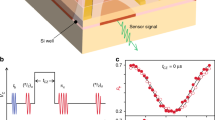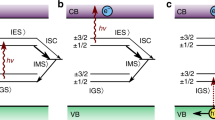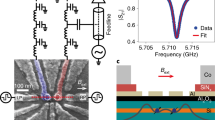Abstract
The size of silicon transistors used in microelectronic devices is shrinking to the level at which quantum effects become important1. Although this presents a significant challenge for the further scaling of microprocessors, it provides the potential for radical innovations in the form of spin-based quantum computers2,3,4 and spintronic devices5. An electron spin in silicon can represent a well-isolated quantum bit with long coherence times6 because of the weak spin–orbit coupling7 and the possibility of eliminating nuclear spins from the bulk crystal8. However, the control of single electrons in silicon has proved challenging, and so far the observation and manipulation of a single spin has been impossible. Here we report the demonstration of single-shot, time-resolved readout of an electron spin in silicon. This has been performed in a device consisting of implanted phosphorus donors9 coupled to a metal-oxide-semiconductor single-electron transistor10,11—compatible with current microelectronic technology. We observed a spin lifetime of ∼6 seconds at a magnetic field of 1.5 tesla, and achieved a spin readout fidelity better than 90 per cent. High-fidelity single-shot spin readout in silicon opens the way to the development of a new generation of quantum computing and spintronic devices, built using the most important material in the semiconductor industry.
This is a preview of subscription content, access via your institution
Access options
Subscribe to this journal
Receive 51 print issues and online access
$199.00 per year
only $3.90 per issue
Buy this article
- Purchase on Springer Link
- Instant access to full article PDF
Prices may be subject to local taxes which are calculated during checkout




Similar content being viewed by others
References
Levi, A. J. F. Towards quantum engineering. Proc. IEEE 96, 335–342 (2008)
Loss, D. & DiVincenzo, D. P. Quantum computation with quantum dots. Phys. Rev. A 57, 120–126 (1998)
Kane, B. E. A silicon-based nuclear spin quantum computer. Nature 393, 133–137 (1998)
Hollenberg, L. C. L., Greentree, A. D., Fowler, A. G. & Wellard, C. J. Two-dimensional architectures for donor-based quantum computing. Phys. Rev. B 74, 045311 (2006)
Žutić, I., Fabian, J. & Das Sarma, S. Spintronics: fundamentals and applications. Rev. Mod. Phys. 76, 323–410 (2004)
Tyryshkin, A. M., Lyon, S. A., Astashkin, A. V. & Raitsimring, A. M. Electron spin relaxation times of phosphorus donors in silicon. Phys. Rev. B 68, 193207 (2003)
Feher, G. & Gere, E. A. Electron spin resonance experiments on donors in silicon. II. Electron spin relaxation effects. Phys. Rev. 114, 1245–1256 (1959)
Ager, J. W. et al. High-purity, isotopically enriched bulk silicon. J. Electrochem. Soc. 152, G448–G451 (2005)
Jamieson, D. N. et al. Controlled shallow single-ion implantation in silicon using an active substrate for sub-20-keV ions. Appl. Phys. Lett. 86, 202101 (2005)
Angus, S. J., Ferguson, A. J., Dzurak, A. S. & Clark, R. G. Gate-defined quantum dots in intrinsic silicon. Nano Lett. 7, 2051–2055 (2007)
Morello, A. et al. Architecture for high-sensitivity single-shot readout and control of the electron spin of individual donors in silicon. Phys. Rev. B 80, 081307(R) (2009)
Ladd, T. D. et al. Quantum computers. Nature 464, 45–53 (2010)
Elzerman, J. M. et al. Single-shot read-out of an individual electron spin in a quantum dot. Nature 430, 431–435 (2004)
Hanson, R. et al. Single-shot readout of electron spin states in a quantum dot using spin-dependent tunnel rates. Phys. Rev. Lett. 94, 196802 (2005)
Barthel, C., Reilly, D. J., Marcus, C. M., Hanson, M. P. & Gossard, A. C. Rapid single-shot measurement of a singlet-triplet qubit. Phys. Rev. Lett. 103, 160503 (2009)
Devoret, M. H. & Schoelkopf, R. J. Amplifying quantum signals with the single-electron transistor. Nature 406, 1039–1046 (2000)
Goswami, S., et al. Controllable valley splitting in silicon quantum devices.Nature Phys. 3, 41–45 (2007); published online 10 December 2006.
Morton, J. J. L. et al. Solid-state quantum memory using the 31P nuclear spin. Nature 455, 1085–1088 (2008)
Hofmann, F. et al. Single electron switching in a parallel quantum dot. Phys. Rev. B 51, 13872–13875 (1995)
Huebl, H. et al. Electron tunnel rates in a donor-silicon single electron transistor hybrid. Phys. Rev. B 81, 235318 (2010)
Tan, K. Y. et al. Transport spectroscopy of single phosphorus donors in a silicon nanoscale transistor. Nano Lett. 10, 11–15 (2010)
DiVincenzo, D. P. The physical implementation of quantum computation. Fortschr. Phys. 48, 771–783 (2000)
Hanson, R., Kouwenhoven, L. P., Petta, J. R., Tarucha, S. & Vandersypen, L. K. Spins in few-electron quantum dots. Rev. Mod. Phys. 79, 1217–1265 (2007)
Hasegawa, H. Spin-lattice relaxation of shallow donor states in Ge and Si through a direct phonon process. Phys. Rev. 118, 1523–1534 (1960)
Hayes, R. R. et al. Lifetime measurements (T 1) of electron spins in Si/SiGe quantum dots. Preprint at 〈http://arxiv.org/abs/0908.0173〉 (2009)
Xiao, M., House, M. G. & Jiang, H. W. Measurement of the spin relaxation time of single electrons in a silicon metal-oxide-semiconductor-based quantum dot. Phys. Rev. Lett. 104, 096801 (2010)
de Sousa, R. Dangling-bond spin relaxation and magnetic 1/f noise from the amorphous-semiconductor/oxide interface: theory. Phys. Rev. B 76, 245306 (2007)
Shankar, S., Tyryshkin, A. M., He, J. & Lyon, S. A. Spin relaxation and coherence times for electrons at the Si/SiO2 interface. Preprint at 〈http://arxiv.org/abs/0912.3037〉 (2009)
Calderón, M. J., Saraiva, A., Koiller, B. & Das Sarma, S. Quantum control and manipulation of donor electrons in Si-based quantum computing. Appl. Phys. Lett. 105, 122410 (2009)
Xiao, M., Martin, I., Yablonovitch, E. & Jiang, H. W. Electrical detection of the spin resonance of a single electron in a silicon field-effect transistor. Nature 430, 435–439 (2004)
Acknowledgements
We thank D. D. Awschalom, C. Tahan, J. J. L. Morton and G. Prawiroatmodjo for comments and suggestions, W. H. Lim for assistance with device fabrication, and R. P. Starrett, D. Barber, A. Cimmino and R. Szymanski for technical assistance. We acknowledge support from the Australian Research Council, the Australian Government, the US National Security Agency and the US Army Research Office under contract number W911NF-08-1-0527. M.M. acknowledges support from the Academy of Finland and the Emil Aaltonen foundation.
Author information
Authors and Affiliations
Contributions
A.M., H.H., C.D.N., D.N.J., C.C.E., L.C.L.H., R.G.C. (while at UNSW) and A.S.D. conceived and designed the experiment, K.W.C. and K.Y.T. fabricated the devices, C.Y., J.A.v.D., A.D.C.A. and D.N.J. implanted the P donors, A.M., J.J.P. and F.A.Z. performed and analysed the measurements, A.M., M.M. and J.J.P. analysed the readout fidelity. A.M. wrote the manuscript with input from all coauthors
Corresponding author
Ethics declarations
Competing interests
The authors declare no competing financial interests.
Supplementary information
Supplementary Information
The file contains Supplementary Information on Deterministic loading of the spin ground state and measurement of the Zeeman energy splitting, measurement methods and analysis of the spin relaxation rate and readout fidelity and calculation of the distribution of peak currents. The file also contains Supplementary Figures 1-4 with legends and additional references. (PDF 509 kb)
Rights and permissions
About this article
Cite this article
Morello, A., Pla, J., Zwanenburg, F. et al. Single-shot readout of an electron spin in silicon. Nature 467, 687–691 (2010). https://doi.org/10.1038/nature09392
Received:
Accepted:
Published:
Issue Date:
DOI: https://doi.org/10.1038/nature09392
This article is cited by
-
Navigating the 16-dimensional Hilbert space of a high-spin donor qudit with electric and magnetic fields
Nature Communications (2024)
-
Electrical manipulation of a single electron spin in CMOS using a micromagnet and spin-valley coupling
npj Quantum Information (2023)
-
Phonon-assisted nearly pure spin current in DNA molecular chains: a multifractal analysis
Scientific Reports (2023)
-
Coupling and readout of semiconductor quantum dots with a superconducting microwave resonator
Science China Physics, Mechanics & Astronomy (2023)
-
Direct characteristic-function tomography of the quantum states of quantum fields
Science China Physics, Mechanics & Astronomy (2023)
Comments
By submitting a comment you agree to abide by our Terms and Community Guidelines. If you find something abusive or that does not comply with our terms or guidelines please flag it as inappropriate.



